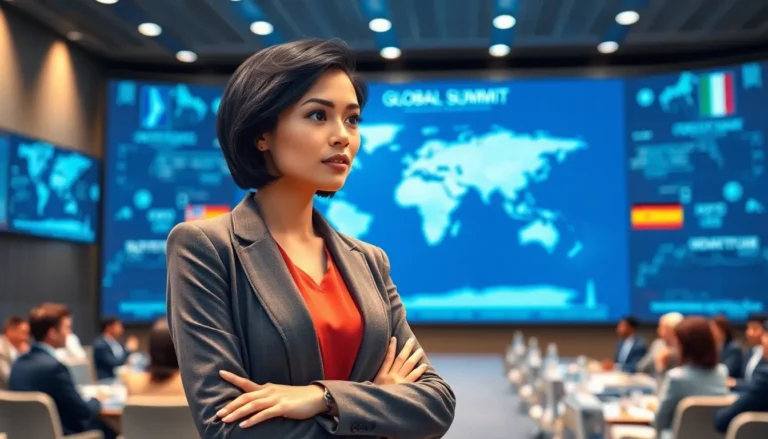In a world where crises seem to pop up like weeds in a garden, humanitarian diplomacy steps in like a well-dressed superhero. It’s the art of blending compassion with negotiation, ensuring aid gets to those who need it most while keeping political tensions at bay. Think of it as the ultimate diplomatic dance-off, where every step counts and the stakes couldn’t be higher.
Humanitarian diplomats juggle the delicate balance of empathy and strategy, navigating complex situations with grace and a dash of humor. They’re the unsung heroes who work tirelessly behind the scenes, transforming chaos into collaboration. As they tackle global challenges, their efforts remind us that diplomacy isn’t just about politics; it’s about people. So, buckle up for a deep dive into the fascinating world of humanitarian diplomacy, where kindness meets strategy in the most unexpected ways.
Table of Contents
ToggleUnderstanding Humanitarian Diplomacy
Humanitarian diplomacy focuses on providing assistance while navigating complex political landscapes. This approach aims to deliver aid effectively, prioritizing human needs amid conflict and crises.
Definition and Key Concepts
Humanitarian diplomacy involves advocacy and negotiation to ensure humanitarian principles receive recognition and support during crises. Key concepts include the importance of impartiality, neutrality, and independence in humanitarian actions. Understanding these principles helps humanitarian diplomats address the needs of affected populations while reducing the risks associated with political interference. Effective communication skills play a critical role in promoting collaboration among diverse stakeholders, including governments, NGOs, and local communities.
Historical Context
Historical events shape the evolution of humanitarian diplomacy. The establishment of the International Committee of the Red Cross in 1863 marked a significant milestone in humanitarian efforts. Following World War II, the adoption of the Geneva Conventions reinforced the necessity for humanitarian diplomacy in armed conflicts. Various crises, such as the Rwandan Genocide in 1994 and the Syrian Civil War beginning in 2011, highlighted the challenges humanitarian diplomats face. These events prompted advocacy for protecting humanitarian access and addressing the needs of vulnerable populations during times of war.
The Role of Humanitarian Diplomacy in Crises
Humanitarian diplomacy plays a critical role during crises, ensuring that aid reaches those in need while navigating complex political environments. It emphasizes the human aspect of diplomacy, fostering collaboration among various stakeholders.
Case Studies
The Syrian Civil War illustrates the challenges humanitarian diplomats face. In this conflict, effective negotiation enabled NGOs to deliver essential services, despite ongoing violence. Another notable case is the Rwandan Genocide, where humanitarian interventions highlighted the need for swift, decisive action amid political turmoil. Both situations showcase how diplomacy shapes responses to humanitarian needs, reinforcing the importance of advocacy in preserving lives and maintaining access.
Impact on Humanitarian Aid
Humanitarian diplomacy directly influences the effectiveness of aid delivery. By promoting partnerships among governments, NGOs, and local communities, it enhances coordination and resource allocation. Improved communication strategies enable faster response times, increasing the likelihood of successful interventions. The focus on impartiality and neutrality strengthens trust, fostering cooperation in volatile regions. Overall, humanitarian diplomacy is vital for ensuring that assistance reaches the most vulnerable populations during crises.
Challenges Facing Humanitarian Diplomacy
Humanitarian diplomacy encounters numerous challenges that impede effective aid delivery. Political dynamics and ethical concerns create significant barriers for practitioners in the field.
Political Obstacles
Political obstacles create complexities in humanitarian diplomacy. Conflicts often arise from competing interests among governments and factions. Negotiating access to distressed areas remains a daunting task, as many states resist external interference. Diplomatic missions experience restrictions that hinder the flow of aid, leaving vulnerable populations without necessary assistance. Relationships between NGOs and local governments can become strained, complicating logistics. Involvement in political disagreements or military actions can damage the perception of neutrality, further exacerbating these challenges.
Ethical Dilemmas
Ethical dilemmas frequently arise in humanitarian settings, complicating the work of diplomats. Decision-making often requires weighing the immediate needs of populations against long-term political ramifications. Diplomatic representatives may face pressure to align with certain political agendas, putting principles of impartiality at risk. Balancing humanitarian goals and the necessity to engage with various stakeholders remains a persistent challenge. Field workers sometimes witness human rights violations, creating moral conflicts regarding reporting or intervening. Each decision carries weight, and the implications on vulnerable communities demand careful consideration.
Future Trends in Humanitarian Diplomacy
Emerging trends indicate significant shifts in humanitarian diplomacy. Organizations are responding to new challenges while adapting their approaches.
Technological Innovations
Technological advancements transform humanitarian diplomacy. Digital communication tools enhance the speed and efficiency of information sharing among stakeholders. Drones facilitate rapid delivery of aid to inaccessible areas, making logistics more effective. Furthermore, data analytics identify needs and improve response strategies, allowing for better-targeted interventions. Social media platforms engage communities directly, allowing them to voice their concerns and needs. By leveraging these technologies, humanitarian diplomats amplify the impact of their efforts.
Evolving Global Dynamics
Evolving global dynamics shape the landscape of humanitarian diplomacy. Geopolitical tensions often complicate negotiating efforts, impacting access to vulnerable populations. Increased migration, driven by conflict and climate change, creates new humanitarian challenges. As nations collaborate, they must navigate diverse interests and values. Multilateral partnerships gain importance, with NGOs and local actors becoming essential in policy discussions. Furthermore, the rise of non-state actors influences the ability of humanitarian diplomats to mediate effectively. Awareness of these dynamics is crucial for adapting strategies in humanitarian efforts.
Humanitarian diplomacy stands at the intersection of compassion and strategy. It plays a crucial role in ensuring that aid reaches those in need, even amidst political turmoil. The challenges faced by humanitarian diplomats are significant but not insurmountable. Their ability to navigate complex environments while maintaining impartiality is vital for fostering collaboration among stakeholders.
As the landscape of humanitarian diplomacy evolves with technological advancements and shifting global dynamics, the need for skilled diplomats becomes even more pronounced. They must adapt to emerging challenges while remaining committed to the core principles of neutrality and independence. Ultimately, humanitarian diplomacy is essential for safeguarding human dignity and addressing urgent needs in times of crisis.









